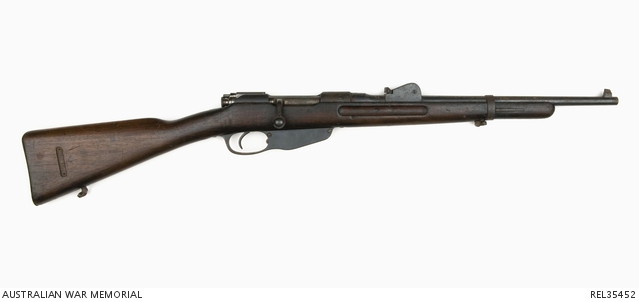| Place | Asia: Netherlands East Indies, Ambon, Pulau, Ambon |
|---|---|
| Accession Number | REL35452 |
| Collection type | Technology |
| Object type | Firearm |
| Physical description | Metal; Wood |
| Maker |
Osterreichische Waffenfabrik Gesellshaft, Steyr |
| Place made | Austria |
| Date made | 1896 |
| Conflict |
Second World War, 1939-1945 |
Dutch Mannlicher Model 1895 Carbine : Netherlands East Indies Army

The Dutch Mannlicher Model 1895 bolt action carbine. The left side of the receiver is marked 'STEYR 1896'. It has a single piece wood stock without a top hand guard. There is a rounded rectangular recess in the right sight of the buttstock measuring 48 mm by 10 mm. There is a flat fixed sling loop attached to the bottom of the butt as well as to the lower fore end of the stock. The magazine is a five shot, vertical, clip loaded integral box. The bolt, with a turned down arm, has two locking lugs located at the head of the body and has a thumb safety lever attached to the rear. The sights are a front barley corn blade and a tangent V notch rear. The butt plate is marked 'D 418'. The bolt is marked '2589' at the arm and '89A' at the bolt head, on the bolt rear and on the safety lever. '19' is stamped in front of the magazine.
The Dutch Mannlicher Model 95 carbine was issued to Koninklijk Nederlands Indisch Leger (KNIL) troops in the Netherlands East Indies during the Second World War. This example was collected by a crew member of HMAS Glenelg while repatriating Australian Prisoners of War from the island of Ambon at the end of the Second World War. In late 1941, Ambon was defended by the Royal Netherlands East Indies Army Garrison, 'Gull Force' made up of the Australian 8th Division's 2/21Battalion, as well as some divisional artillery and support units. The invading Japanese forces landed on the island on 30 January 1942 and the last allied troops on Ambon surrendered on 3 February 1942. After the surrender, more than 300 Australian and Dutch Prisoners of War were chosen at random and executed.